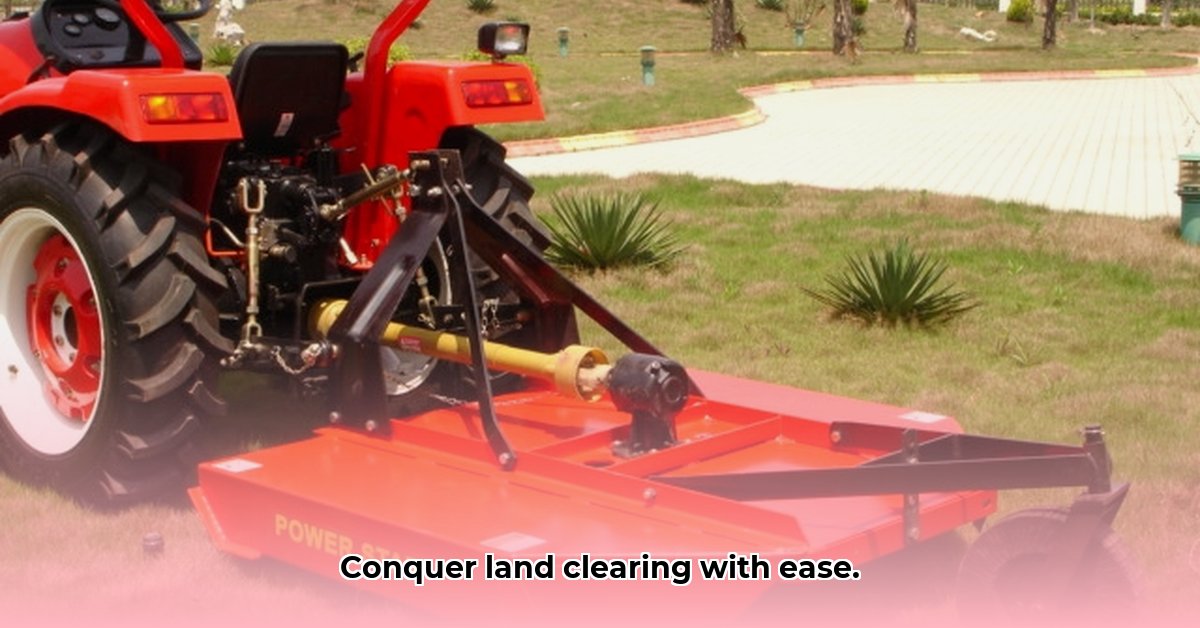
Choosing the Right Bush Hogging Setup
Selecting the appropriate tractor and rotary cutter is paramount for efficient and safe land clearing. Several key factors must be considered before you begin.
For more information on brush hogging equipment, check out this helpful resource.
Matching Tractor Horsepower to the Job
Tractor horsepower directly impacts cutting capacity and the ability to navigate challenging terrain. More horsepower translates to a more efficient clearing process, especially on larger properties with dense vegetation or hilly landscapes. Underpowering your setup risks damage to the equipment and compromises operator safety. Do you intend to clear acres of dense brush, or just tidy up a small paddock? This consideration significantly impacts your horsepower requirement.
Assessing Your Land for Optimal Cutter Selection
The size of your land, terrain complexity, and vegetation density determine the ideal cutter width. Wider cutters provide faster coverage but demand more powerful tractors. Steep slopes necessitate specialized cutters designed to prevent rollovers and maintain stability. Remember, choosing the wrong cutter can lead to inefficient operation and potential safety hazards. What is the overall topography of your land? Is it flat, gently rolling, or significantly sloped?
Budgetary Considerations and Long-Term Costs
Bush hogging equipment ranges in price, from relatively affordable to high-end models. Consider both initial costs and long-term expenses, including maintenance, repairs, and fuel consumption. Choosing a reliable brand with readily available parts minimizes downtime and unexpected expenses. A well-maintained machine represents a significant long-term investment. How much can you realistically afford to spend on equipment, maintenance, and fuel?
Safety First: Pre-Operation Procedures and Personal Protective Equipment (PPE)
Safety remains the top priority when operating heavy machinery like bush hogging tractors. A thorough pre-operation check is crucial.
Essential Pre-Operation Checklist
Before starting the engine, adhere to this strict checklist:
- Fluid Levels: Inspect and top off fuel, hydraulic fluid, engine oil, and coolant as needed. (Ensuring adequate fluids prevents equipment failure.)
- PTO Shaft Inspection: Carefully examine the Power Take-Off (PTO) shaft (the rotating shaft that powers the rotary cutter) for any damage or wear. (A damaged PTO is extremely hazardous.)
- Safety Guard Verification: Verify that all safety guards are securely attached and functioning correctly. (Never operate without complete safety measures.)
- Brake and Steering Test: Thoroughly test brakes and steering mechanisms to ensure complete control of the tractor. (Loss of control can lead to serious accidents.)
- Obstacle Removal: Clear the work area of rocks, logs, debris, and any other potential hazards. (Flying debris from a rotary cutter can cause serious injury.)
- Blade Sharpness Check: Ensure that the rotary cutter blades are sharp. Dull blades are less efficient and increase the risk of equipment damage and injury. (Sharp blades reduce strain on the tractor and increase safety.)
Personal Protective Equipment (PPE) Requirements
Always wear appropriate PPE:
- Safety Glasses or Goggles: Protect your eyes from flying debris.
- Hearing Protection: Reduce the risk of hearing damage from the loud noise.
- Sturdy Work Boots: Provide ankle support and protection from potential hazards.
- Gloves: Protect your hands from cuts and abrasions.
- Long Pants and Sleeves: Offer protection from flying debris and reduce the risk of abrasion injuries.
Mastering Bush Hogging Techniques: Step-by-Step Operation
Setting Up for Efficient Cutting
- Adjust Cutter Height: Adjust the rotary cutter’s height to suit the terrain and vegetation. Too low risks damage; too high results in an uneven cut.
- Initial Pass: Begin by making a slow, even pass to clear the area.
- Overlap Passes: Slightly overlap your passes to ensure complete coverage and prevent missed patches of vegetation.
- Smooth Operation: Avoid sudden stops or starts, maintaining a consistent speed for efficient cutting.
- Maneuvering: Use smooth, controlled turns. Avoid abrupt turns, which can cause loss of control or damage to the equipment.
Maintaining a Safe Operating Distance
Always maintain a safe distance from the rotating blades. Never approach the cutter while it is in operation.
Addressing Unexpected Situations
Should the tractor or cutter stall, immediately disengage the PTO before attempting troubleshooting.
Maintenance and Troubleshooting: Extending Equipment Lifespan
Regular maintenance is crucial for preventing costly repairs and ensuring prolonged equipment lifespan.
Post-Operation Cleaning and Inspection
Thoroughly clean the rotary cutter after each use, removing any debris. Inspect blades, shafts, and belts for damage. Regular lubrication of moving parts extends their lifespan.
Addressing Common Issues
Minor issues, such as lubrication problems or blade wear, should be promptly addressed to prevent escalation. Refer to your owner’s manual for specific troubleshooting steps. Remember: preventative maintenance saves money and prevents accidents.
Environmental Considerations: Minimizing Your Impact
Brush hogging impacts the environment.
Erosion Control, Biodiversity and Soil Health
To minimize erosion, avoid operating on steep slopes when the soil is wet. Consider leaving areas un-hogged to support biodiversity and maintain soil health. Proper cutting height minimizes soil disturbance.
Waterways Protection and Waste Disposal
Avoid brush hogging near water bodies to prevent water pollution. Proper disposal of waste from clearing operations is critical for environmental sustainability.
Legal and Regulatory Compliance: Adhering to Local and National Standards
Brush hogging regulations vary by location. Before starting work, ensure you fully understand and comply with all applicable local, state, and federal regulations related to land clearing, equipment use, and environmental protection. Failure to comply may result in penalties.
Conclusion: Safe and Efficient Land Management Practices
Bush hogging tractors are powerful tools for efficient land management. Prioritizing safety, following proper operating techniques, and adhering to regulations leads to successful land clearing while minimizing environmental impact. Remember, your safety and environmental responsibility are paramount.